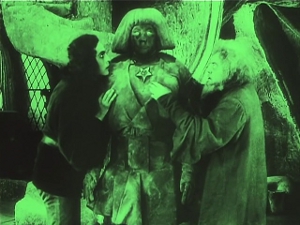
Any student of horror stories will tell you messing with otherworldly forces is a bad idea and it’s an idea that’s been with us since the birth of film. Thomas Edison himself – or his film company, at the very least – produced the first adaption of Frankenstein in 1910. Like half the movies made before 1950, that sixteen minute film was thought lost until the mid-70s. But we’re not talking about that Frankenstein, or the 1915 adaption with the copyright-dodging title Life Without Soul. Today we’re going back to Weimar Germany and the twisted, medieval world of Expressionism.
Mary Shelley brought a lot to the table when she sat down to write her tale of a mad doctor and the life form he created but refused to take responsibility for, manufacturing his own tragedy. That basic outline’s formed the backbone of tall tales from around the world: the Hero who seeks to do Good but ends up doing Evil because he thinks ends justify means. Among them you’ll find the legend of Rabbi Judah Loew ben Bezalel of Prague, who, at some point in the late-15th century, created a golem to defend his ghetto from the latest round of antisemitic expulsion edicts.
No matter who, what, or where you are, there’s always going to be some asshole looking at your ghetto and seeing prime real estate…if only those damned “undesirables” would stop living on it. The idea of creating a communal defender, unbiased by human desire or prejudice, is far from exclusive to any one set of circumstances. But the Golem of Prague entered into legend by turning against its creator and going on a rampage. This was either due to an inherent design flaw…or to the golem making that Big Mistake most homunculi make and falling in love with a human woman who didn’t return his affections. Either way, Rabbi Loew defeated his creation, with either returned to dust and found itself stored in the attic of Prague’s Old New Synagogue, ready to be reanimated should the need ever arise. Continue reading The Golem: How He Came Into the World (1920)
